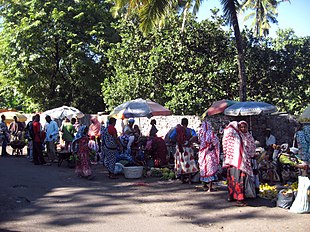 A market place in Moroni | |
| Currency | Comorian franc |
|---|---|
| calendar year | |
Trade organisations | AU, AfCFTA (signed), WTO (observer) |
Country group |
|
| Statistics | |
| GDP | |
| GDP rank | 184th (nominal) / 207th (PPP) |
GDP growth |
|
GDP per capita | |
GDP by sector | agriculture: 50.0%; industry: 10.0%; services: 40.0% (2011 est.)[5] |
| 1.749% (2018)[3] | |
Population below poverty line | 60% (2002 est.) |
| N/A | |
Labour force | 268,500 (2007 est.) |
Labour force by occupation | agriculture: 80%, industry and services: 20% (1996 est.) |
| Unemployment | 20% (1996 est.) |
Main industries | fishing, tourism, perfume distillation |
| External | |
| Exports | $19.6 million (2012 est.) (205th) (2012)[6] |
Export goods | vanilla, ylang-ylang (perfume essence), cloves, copra |
Main export partners |
|
| Imports | $208 million (2012 est.) (206) (2012 est.)[8] |
Import goods | rice and other foodstuffs, consumer goods, petroleum products, cement, transport equipment |
Main import partners |
|
FDI stock | N/A |
Gross external debt | $136.1 million (189th) (31 December 2012)[10] |
| Public finances | |
| N/A | |
| Revenues | N/A |
| Expenses | N/A |
All values, unless otherwise stated, are in US dollars. | |
The economy of the Comoros is based on subsistence agriculture and fishing.[11] Comoros has inadequate transportation links, a young and rapidly increasing population, and few natural resources. The low educational level of the labor force contributes to a subsistence level of economic activity, high unemployment, and a heavy dependence on foreign grants and technical assistance. The Comoros, with an estimated gross domestic product (GDP) per capita income of about $700, is among the world's poorest and least developed nations. Although the quality of the land differs from island to island, most of the widespread lava-encrusted soil formations are unsuited to agriculture. As a result, most of the inhabitants make their living from subsistence agriculture and fishing. Average wages in 2007 hover around $3–4 per day.
Agriculture, including fishing, hunting, and forestry, is the leading sector of the economy. It contributes 40% to GDP, employs 80% of the labor force, and provides most of the exports. The country is not self-sufficient in food production; rice, the main staple, accounts for the bulk of imports.
The government is working to upgrade education and technical training, to privatize commercial and industrial enterprises, to improve health services, to diversify exports, to promote tourism, and to reduce the high population growth rate. Continued foreign support is essential if the goal of 4% annual GDP growth is to be met. At 24 percent of GDP, remittances constitute an important source of inflows for the Comorian economy.[12]
The GDP per capita of the Comoros grew 55% in the 1980s. But this proved unsustainable and it consequently shrank by 42% in the 1990s.
- ^ "World Economic Outlook Database, April 2019". IMF.org. International Monetary Fund. Retrieved 29 September 2019.
- ^ "World Bank Country and Lending Groups". datahelpdesk.worldbank.org. World Bank. Retrieved 29 September 2019.
- ^ a b c d e "World Economic Outlook Database, October 2019". IMF.org. International Monetary Fund. Retrieved 6 December 2019.
- ^ "Global Economic Prospects, January 2020 : Slow Growth, Policy Challenges" (PDF). openknowledge.worldbank.org. World Bank. p. 147. Retrieved 15 February 2020.
- ^ "GDP - Composition by Sector". CIA World Factbook. c. 2011. Archived from the original on June 13, 2007. Retrieved 2013-07-28.
- ^ "2012 Exports figures of Comoros". CIA World Factbook. 2012. Archived from the original on November 1, 2013. Retrieved 2013-07-28.
- ^ "Exports Partners of Comoros". CIA World Factbook. 2013. Archived from the original on June 13, 2007. Retrieved 2015-05-11.
- ^ "2012 Imports figures of Comoros". CIA World Factbook. 2012. Archived from the original on June 16, 2013. Retrieved 2013-07-28.
- ^ "Imports Partners of Comoros". CIA World Factbook. 2013. Archived from the original on June 13, 2007. Retrieved 2015-05-11.
- ^ "2012 External Debt of Comoros". CIA World Factbook. c. 2012. Archived from the original on June 13, 2007. Retrieved 2013-07-27.
- ^ "Comoros". Retrieved 28 October 2019.
- ^ MFW4A Archived May 13, 2011, at the Wayback Machine